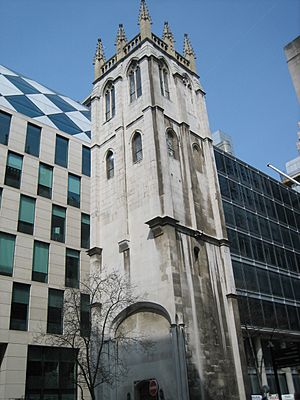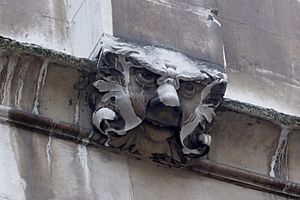St Alban, Wood Street facts for kids
Quick facts for kids St. Alban, Wood Street |
|
|---|---|

The tower of St. Alban's
|
|
| Location | Wood Street, London |
| Country | England |
| Denomination | Anglican |
St Alban's was a church located on Wood Street in the City of London. It was named after Saint Alban, an early Christian saint. This church had a long history, starting in medieval times. It was rebuilt in 1634, but then completely destroyed in the famous Great Fire of London in 1666. After the fire, it was rebuilt again, this time by the famous architect Sir Christopher Wren, who gave it a Gothic look. Sadly, the church was badly damaged by bombs during the Second World War. Most of the church was cleared away, leaving only its tall tower standing today.
Contents
A Look Back in Time
Some people believe that St Alban's church might have started as early as the time of King Offa of Mercia. King Offa was a powerful ruler who lived a very long time ago. He is thought to have had a palace in this area, which included a small chapel. Offa also founded a big church, an abbey, dedicated to Saint Alban in 793. Because of this, several churches in the City of London were later named after Saint Alban.
Records from the church's clerk go all the way back to the year 930! In 1077, the leader of St Albans Abbey traded the right to choose the priest for this church with the leader of Westminster Abbey. This shows how important the church was even then. During the time of King John, the church was known as St Alban Wuderstrate.
In 1633, important people like Inigo Jones were asked to check on the church because it was falling apart. They found it was too damaged to fix, so it was taken down and rebuilt in 1634.
Rebuilt by Christopher Wren
The church was completely destroyed in the Great Fire of London in 1666. But it was rebuilt by the famous architect Sir Christopher Wren. He finished the new church in 1685, designing it in a late Perpendicular Gothic style. This means it had tall, narrow windows and strong vertical lines.
The inside of Wren's church had a main area (called the nave) and side sections (aisles). These were separated by columns that looked like groups of smaller columns. The ceiling of the nave had fancy plaster patterns. After the Great Fire, the church's area (parish) was joined with that of St Olave's, Silver Street, which was not rebuilt.
The church was repaired again in 1858–59 by George Gilbert Scott, who added a rounded section called an apse. The church's tower was 92 feet (about 28 meters) tall and had four pointed tops called pinnacles, which were replaced in 1879.
Damage and What Remains Today
During the Blitz, which was a period of heavy bombing in London during the Second World War, the church was burned out and partly destroyed in 1940. In 1954, the church's parish was combined with St Vedast Foster Lane. The rest of the church building was taken down in 1965.
Only the tower of St Alban's was left standing. Today, this tower is a private home located on a traffic island. The tower is considered a very important historical building, listed as Grade II* since 1950.
The outside of the tower has been used in movies and music videos! It was seen as the headquarters for a group in the 2009 film St Trinian's II: The Legend of Fritton's Gold. It also appeared in a music video for Adam Rickitt's song "Everything My Heart Desires."
Church Records
The old records for St Alban's church are kept at the Guildhall Library. These records include information about burials from 1584 to 1636.
See also


